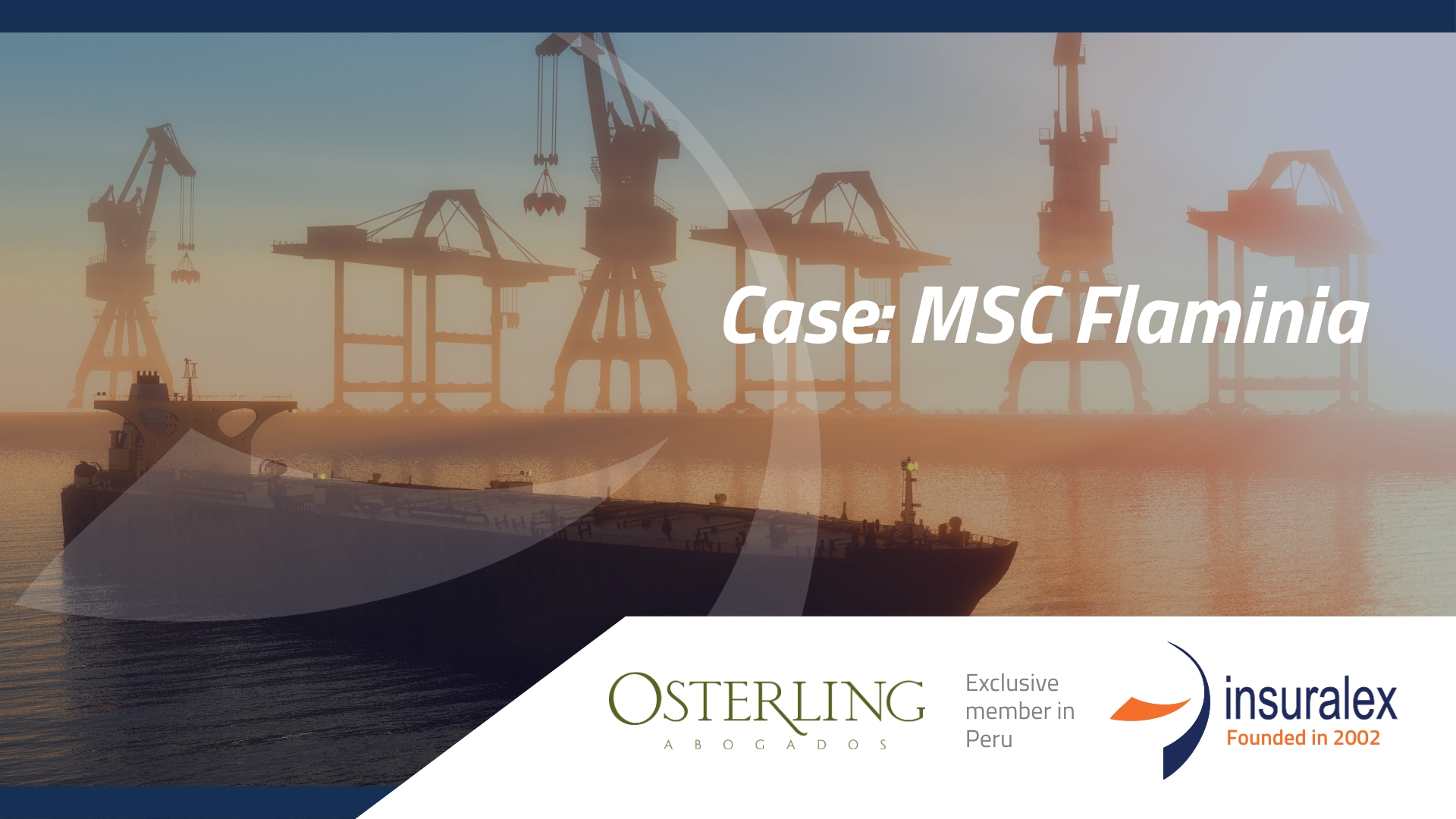
Information Circular – Marine
On September 1ST, 2023, the Court of Appeal of England and Wales (hereinafter, “Court”) issued a judgment on Case No. CA-2022- 002293, between MSC Mediterranean Shipping Company S.A. (hereinafter, “MSC”) and Stolt Tank Containers B.V., Stolt Nielsen USA INC., CONTI 11. Container Schiffahrts, and others (hereinafter, “Defendants”).
The central discussion of the present case concerns the limitation of tonnage under the 1976 Convention on Limitation of Liability for Maritime Claims (hereinafter, “Convention”), since the time charterer of the vessel “MSC Flaminia”, MSC, requests an order that it is entitled to limit its liability to the shipowner, CONTI 11. CONTAINER SCHIFFAHRTS (hereinafter, “CONTI”), due to an explosion that took place in July 2012.
I. Background
On July 14, 2012, the vessel “MSC Flaminia” was in the middle of the Atlantic Ocean when an explosion occurred in the No. 4 cargo hold, resulting in a large fire on board. Hundreds of containers were destroyed, and the ship suffered extensive damage. The explosion was caused by the autopolymerisation of the contents of one or more of three tank containers laden with a chemical substance known as DVB, which had been shipped to New Orleans on 1st July 2012.
As a result of the casualty, the ship was so damaged that she could not complete her voyage to Antwerp. CONTI had to undertake various measures for the ship’s salvage, repairs, and the handling of contaminated materials.
The casualty gave rise to several cargo claims brought in the United States District Court for the Southern District of New York against MSC, CONTI and others, including Stolt-Nielsen USA Inc and Stolt Tank Containers BV (hereinafter, “Stolt”). The District Court found that Stolt and Deltech alone were liable to the cargo claimants. The claims against MSC and CONTI failed, on the contrary, the District Court stated that they were entitled to a full indemnity from Stolt and Deltech against any other claims by cargo claimants.
By means of the arbitration clause contained in the timecharter entered between CONTI and MSC, CONTI brought claims in the arbitration to recover hire throughout the period while the ship was out of service under the charter and to recover its losses as a result of the casualty. The arbitrators determined that the ship remained on hire throughout and that MSC was liable to CONTI in respect of the casualty, therefore they awarded damages of approximately US$200 million.
II. Judgment
MSC appeals by the argument that it can limit its liability for claims arising from the casualty pursuant to the established-on Article 2 of the Convention.
Preliminarily, the Court provides that the only claims which will be discussed in the present case are CONTI’s claims for: (a) the costs of discharging and decontaminating the cargo at Wilhelmshaven, (b) the costs of removing firefighting water from the ship’s holds; (c) payments made to national authorities; and (d) the cost of removing burnt waste material from the ship.
Considering the facts of the case, Judge Justice Andrew Baker stated that the costs actually incurred by CONTI not only needed to be incurred if the ship was to be repaired but were in fact incurred to enable CONTI to have the ship repaired or as part of the repairs themselves. Therefore, the judge held that MSC was not entitled to limit its liability because CONTI’s claims are not within the scope of any of the paragraphs of Article 2.
For MSC, the judge’s arguments were wrong for the following reasons:
- The judge should have held that the cost of removing the cargo from the ship and decontaminating it at Wilhelmshaven fell within Article 2.1(e).
- The judge should have held that the payments to national authorities and the costs of removing firefighting water from the holds were incurred in part in order to avert or minimize loss of or damage to the cargo and therefore fell within Article 2.1(f).
- The judge was wrong to hold that MSC’s liability to CONTI was a single claim in respect of damage to the ship, as opposed to a group of claims, some of which were limitable and some of which were not; the correct approach is to consider whether each particular head of loss does or does not come within one of the paragraphs of Article 2.1.
- The judge should have held that each of CONTI’s claims for (a) the payments to national authorities, (b) the cost of discharging the cargo, (c) the removal and disposal of the firefighting water, and (d) the removal of the cargo waste, was a claim for losses “consequential” on damage to the cargo on board.
CONTI position was that the claims for which a charterer can limit require an underlying original loss or expense to have been suffered or incurred by an “outsider”.
In order to resolve the discussion, the Court established that the Convention should be interpreted by reference to the accepted principles of interpretation set out in Articles 31 and 32 of the Vienna Convention on the Law of Treaties 1969. In this regard, Article 31 of the Vienna Convention established that must ascertain the ordinary meaning of the terms used in their context and in the light of the Convention’s object and purpose, with recourse to supplementary means of interpretation either to confirm the meaning thus ascertained or, in the strictly limited cases identified in Article 32(a) and (b), to determine the meaning.
Lord Justice Longomore states that is necessary to interpret the language of each Convention in the light of its object and purpose and to remember that conferring a right to limit means that the party which has suffered loss and damage will not obtain full compensation if its losses exceed the limitation amount. Therefore, the main object and purpose of the Convention was to provide for a higher limit of liability than applied under the 1957 Convention while making it more difficult to “break” the limit and to extend the right to limit to salvors.
In view of the above, the Court states that when a claim falling within Article 2 is made by an owner against a charterer, the charterer’s right to limit does not depend upon the capacity in which the charterer was acting so as to give rise to the claim, but simply on whether the owner is claiming for a loss which it has suffered itself (no right for charterer to limit) or to pass on liability for a claim made against the owner by a third party (charterer entitled to limit). To the Court was entirely clear that under the 1957 Convention, a charterer had no right to limit in respect of claims by an owner to recover losses suffered by the owner
itself. The same idea can be expressed another way by saying that a charterer cannot be liable “in the same way” as an owner would be in respect of a claim brought by the owner against the charterer for breach of the charterer’s obligations under the charter party.
The Court held that Article 2.1(e) does not depend on the reason why it is necessary to remove the cargo or to render it harmless, although in practice the need to do so is often likely to be associated with damage suffered by the ship. Nor does it depend on the shipowner’s purpose in incurring such costs. A charterer’s right to limit under Article 2.1(e) should not depend on the potentially fluctuating plans of the owner. Rather, the Article is concerned simply with the nature of the claim.
In addition, the Court determined that Article 2.1(f), in contrast with Article 2.1(e), requires consideration of the purpose for which the measures in question were taken. For the Court, it is sufficient that the main or dominant purpose of the measures in question should be to avert or minimize loss for which the person liable may limit liability. That is a test which is familiar in maritime law.
Consequently, the Court concluded that damage to the ship does not give rise to a claim which is subject to limitation, as held in The CMA Djakarta case. Accordingly, MSC is not entitled to limit under Article 2.1(a) For all of the above reasons, the Court dismissed the appeal.
For further information contact us:
Partner
Associate




